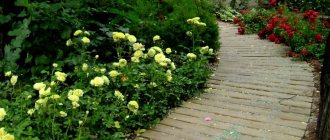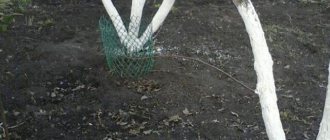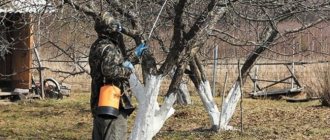Autumn is a deceptive time of year; during the day the weather can delight us with its warmth and sun, and at night the thermometer can sometimes reach 0 degrees. Due to such unstable temperatures, many crops are unable to bear fruit.
How to help plants prepare for winter? What work must be done in the fall at the dacha? We will look at the answers to these questions in this article.
Harvest
Autumn is primarily harvest time.
1. In September, autumn and winter varieties of apples and pears are harvested. But it is important to remove fruits from branches correctly so that they can be stored for as long as possible:
- fruits should be picked when it’s cool outside (fruits picked in the heat and left in the sun have a much worse shelf life and shorter lifespan);
- pick fruits with gloves so as not to accidentally scratch them, and with stalks, fruits are stored with them longer;
- It is recommended to remove fruits first from the lower branches of the tree, then from above - this reduces the risk of injuring apples and pears;
- Do not wipe the fruits, let the natural protective wax remain on them - this way you will extend their shelf life.
2. Clear the beds with tomatoes and peppers. These vegetables are unlikely to be able to fully ripen, so you can also collect green fruits. They can ripen at home, in the closet. Just so that vegetables are better stored and are not subject to rotting processes, they need to be thoroughly washed with soda.
3. Greenhouse crops can easily bear fruit until freezing temperatures set in, so do not rush to remove them from the greenhouse.
4. It is best to pick carrots from the beds at the end of September, when the first frosts arrive. Being in the garden, it is better stored and saturated with vitamins.
5. It is recommended to dig up beets in early September, before the first frost, because If it freezes, it will not be stored.
6. Potatoes are harvested according to the planted variety, usually in September-early October.
7. In general, each root vegetable has its own assembly time, which is important to observe, because the duration of storage directly depends on them.
8. Root parsley is harvested in the middle of the month, from September 15 to 25.
It is recommended to sow beds emptied of crops with green manure, which are chosen depending on what plants will be planted in the bed in the spring. Green manure loosens the soil, filling it with useful substances.
Trimming
I don't recommend doing major pruning in the fall. At this time, you can only rid the trees of dry, diseased and broken branches. The trimmings should then be burned or shredded and placed at the bottom of the compost pile as drainage. The layer must be at least 15 cm.
Provided the correct dosage of dry and green organic matter, regular watering and mixing of the contents of the compost heap, by spring all harmful organisms in it will die, the remains will rot, and you will get excellent fertilizer.
Autumn soil preparation for winter
Autumn tillage will help not only increase soil fertility, but also get rid of harmful insects, weeds and various diseases.
Soil cultivation to prevent diseases and pests
It is recommended to begin tillage immediately after harvesting, because Plant residues can harbor harmful microorganisms, rot and fungi, which will subsequently infect the ground.
The beds need to be put in order, cleared of weeds, fruits and dry tops. It is not necessary to burn the collected garbage; you can simply put it in compost, because it does not have suitable conditions for the development of pathogenic microflora.
Loosening the top layer of soil
Immediately after clearing the beds of plant debris, loosen them to a depth of 4 cm. This will help destroy the crust that has formed on the soil.
It is important to have time to carry out the loosening process before the onset of cold weather, because... it provokes the growth of weeds, the seedlings of which will die during frosts. And this, in turn, will help reduce weeding in the spring.
Digging the soil
Digging in the fall is useful, but not for all types of soil. For example, it will not bring any effect to sandy soil, but it will significantly improve the structure of heavy loamy soil.
In addition, autumn digging has other advantages:
- helps in the fight against pests and diseases, because clods of earth turned to the surface freeze and are disinfected;
- helps reduce the number of weeds that die after digging;
- More snow accumulates on the dug surface, thus the soil is deeply saturated with snow moisture.
Advice: it is better to dig up the soil before the beginning of October. More precisely, before the heavy rains arrive. After all, soil that is wet to a depth of more than 10 cm cannot be dug up; this may damage its structure.
It is recommended to dig up the soil to a depth of about 20 cm, turning over the lumps, but there is no need to specifically break them up and level the bed.
Work in the garden
There are several big jobs that need to be done in the garden before winter. It’s time to sow all those plants that can be planted in the fall and will not freeze in frosts or plant tubers or roots in the ground. This technique will help start next year's harvest a few weeks earlier.
When planting in winter, you need to be prepared that not all plants or seeds will be able to survive the frost, so the amount of seeding material is slightly increased.
In this way, parsley, leeks, and cilantro are sown in winter. They try to plant some crops so that they grow faster in the spring and gain strength during the first spring rains. These include carrots, onions, and garlic.
Garlic can be planted before winter
To ensure that the seeds do not freeze and successfully survive the winter cold, follow these tips:
1. Start sowing work when the first small but stable frosts have just begun. In this case, the seeds will not have time to germinate in the fall, but will be slightly saturated with moisture.
- Be sure to plant the seeds dry and do not let them germinate first.
- At the end of October you can plant onions and garlic for the winter.
Onions can be planted at the end of October
- After sowing, cover the seeds with soil and cover with peat. It will not allow a crust to form on the surface and will protect from the cold.
- Place a layer of leaves on top of the peat and cover them with branches. These measures will save the seeds from wind and blowing away.
The leaves will protect the seeds from blowing away
Mulching the soil in autumn
Tree trunk circles and beds are covered with mulch so that crops can survive the winter safely. Mulch should be laid in late autumn, when the top layer of soil has already begun to freeze.
The thickness of the mulching material should be at least 5-10 cm, then you will achieve the desired result. If the mulch layer is less than 5 cm, then it will have no effect.
Benefits of autumn mulching:
- by spring, autumn mulch rots and promotes better soil warming, as well as rapid germination of crops;
- retains moisture well in the soil;
- protects the soil from sudden temperature changes, frosts in winter and overheating in spring;
- rotting, it releases a layer of humus that feeds the plants;
- helps to avoid the formation of crust on the ground after watering or rain;
- blocks weed growth.
Mulch options:
- conifer bark,
- compost,
- peat,
- humus,
- sawdust,
- straw,
- needles,
- dry leaves,
- pine nut shells
Sanitary pruning of the garden
In the fall, it is necessary to remove all dry and old, as well as poorly located, diseased and damaged branches from trees and shrubs.
Branches and shoots infected with diseases should under no circumstances be left on the site; they should be burned. Otherwise, they will serve as a source of new infections in your area.
Preparing seeds for planting
In order to avoid having to spend a lot of money on buying seeds next year, they start preparing them ahead of time. All collected testes are collected in dry weather, laid out on paper and allowed time to dry. Dry seeds are separated, placed in bags and stored in a dry, ventilated area until next year.
Store seeds in bags in a dry place
Melons, tomatoes, and cucumbers selected for seeds are left to ripen for several weeks. Then the seeds are selected, placed in water along with the pulp for several days, separated and left to dry in a well-ventilated area.
We add fertilizers and additives to the soil in the fall
Manure
Fresh manure contains many weed seeds. In the spring it should not be used in its pure form, but in the fall the following crops can be added when preparing the soil for planting:
- cucumbers,
- zucchini,
- pumpkins,
- melons,
- dill,
- celery,
- late cabbage
If the manure contains a lot of straw or sawdust, then in the first year after its application, the crops will need additional nitrogen fertilizing.
Compost and humus
Humus and compost can be added to the soil in both autumn and spring. As for autumn application, some of the nutrients may be washed out by meltwater during the winter, but the organic matter reaches the optimal moisture level and then easily mixes with the soil.
Typically, humus or compost is applied after harvesting to the following crops:
- strawberries,
- raspberries,
- currants
- apple trees,
- other perennial fruit crops and flowers.
Peat
Peat contains few nutrients, but it loosens clay soil well and increases the moisture capacity of sandy soil.
If your site has heavy, poorly cultivated soil, then you can add peat in the fall as follows:
- during autumn digging, add 4-5 liters of peat per 1 m2,
- then in the spring - the same amount of peat or humus and dig again.
This will help mix the organic material evenly with the soil and make it easy to break up large clumps of clay.
Liming the soil in autumn
Lime, chalk, ash, dolomite flour and other liming additives are added to the soil to reduce acidity levels.
It is recommended to apply lime only in the fall, because it slows down the absorption of phosphorus. And in order not to harm the plants, it is necessary that several months pass after adding this additive before the start of active growing season.
Dolomite or limestone flour, chalk and ash can be added to the soil at any time.
Mineral fertilizers
In the fall, areas under perennial crops need phosphorus, potassium and nitrogen fertilizers. Either all separately, or using complex mineral fertilizers.
Mineral fertilizers are evenly scattered under fruit trees and shrubs and then watered. Application rates are indicated in the table per 1 tree/bush:
| Tree/bush | Application rates | Application period |
| apple and pear trees | 1.5 cups of superphosphate and 1 cup of potassium sulfate | after harvesting the fruits |
| cherry | 1 cup superphosphate and 3 tbsp. spoons of potassium sulphide | in mid-September |
| currant | 1/2 cup superphosphate and 2/3 cup potassium sulfate | at the end of September |
| gooseberry | 1.5 tbsp. spoons of superphosphate and 4 tbsp. spoons of potassium sulfate | at the end of September |
We water the plot in the fall
Typically, watering the area is carried out before frost, when the leaves have completely fallen. This will protect the soil and plant roots from freezing. Because wet soil retains heat well, while dry soil, on the contrary, easily allows air to pass through and quickly cools to its temperature, as a result of which the root system of plants is damaged.
It is necessary to water abundantly so that the soil is wet to a depth of 60 cm. It is recommended to pour on each tree:
- 40-50 l. — for light sandy soils;
- 60-70 l. – for loamy soils;
- 80-90 l. - for heavy clay soils.
Procurement of medicinal plants
All plants whose roots have a medicinal effect are dug up in the fall. The rhizomes are washed, blotted with a napkin, and cut into small pieces. Dry the roots in dry, ventilated places; the attic is ideal for this purpose. Store already dried medicinal compounds in glass jars with lids.
Method of storing medicinal plants
When the basements are full, it's time to start preparing your garden for winter.
We fight diseases and pests in the fall
It makes no sense to spray plants and trees against pests and diseases in the autumn. The only optimal treatment that should be carried out in the fall is spraying trees, shrubs and the soil around them with a concentrated urea solution.
To prepare the fertilizer, dilute 500 - 700 grams of urea per bucket of water. This spraying is carried out during active leaf fall or after it.
Pest protection: what to do?
The less garbage and various plant debris there is in the garden, the harder it is for pests to find a secluded place to hibernate. That’s why it’s so important to remove fallen leaves and burn old tops. Digging up the soil in the autumn destroys the passages of caterpillars and contributes to the freezing of insects overwintering in the upper layer of soil. Cleaning tree trunks of old bark, moss and dry branches, and whitening the trunks with lime help get rid of parasites that live and lay eggs in the folds and cracks of wood.
To destroy cocoons of codling moths, all trees need to be sprayed with a 5% solution of carbamide (urea); the drug Fury is suitable for leaf rollers and silkworms. To prevent fungal diseases, plantings are treated with solutions containing copper (copper sulfate or Bordeaux mixture). To protect against scab, use Strobi or Impact.
Whitening trees in autumn
Typically, trees are painted in the fall or at the very beginning of winter. To do this, use garden paint with the addition of fungicides and a good adhesive base. It is better not to use water-based whitewash, otherwise it will quickly be washed away by rain.
This will help protect the trees from pests and diseases, and in the spring it will protect them from sunburn.
Whitewash
The trunks and skeletal branches of all trees must be whitened with lime or special paints, which can be purchased at a garden store. Whitewashing will block the access of air to harmful microorganisms and pest larvae that might not have died after treatment with vitriol, and thus you will get rid of them. Whitewashing is, as they say, a control shot at the enemies of your garden.
In addition, at the end of winter, sharp changes between day and night temperatures begin, which often lead to cracking of the bark and wood of the trees. The wounds become infected and begin to rot.
If frostbite is not treated, the affected branch, and sometimes the entire tree, can die within two years. Whitewashing will protect the bark from frost damage. The trunks and branches should be coated with a protective composition to the height that can be reached.
- How to preserve grape cuttings until spring?











